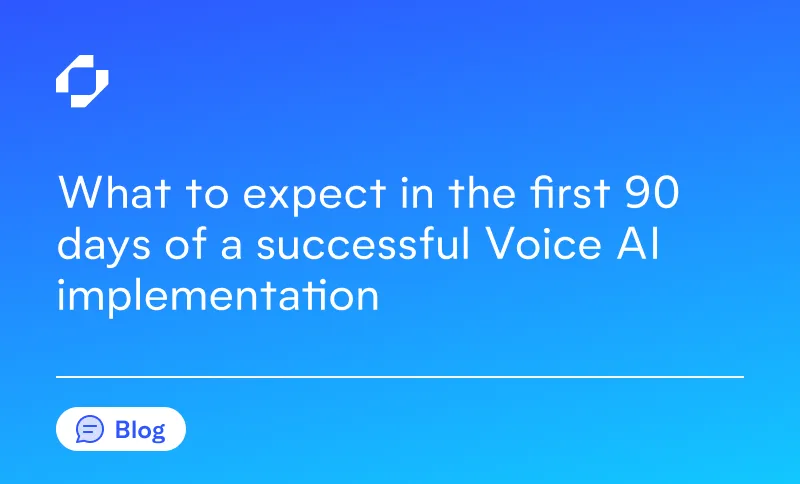Conversational AI has become essential across industries, transforming how businesses interact with customers. While Google's Dialogflow remains a popular choice for building chatbots and voicebots, it's not always the perfect fit for every organization's needs.
This article explores what Dialogflow offers, why teams might look for alternatives, and presents ten compelling options that could better serve your conversational AI requirements including Replicant, PolyAI, Kore.ai, Sierra, Decagon, Vapi, Amazon Lex, Microsoft Azure Bot Service, Ada, and LivePerson.
What is Dialogflow?
Dialogflow is Google's platform for developing chatbots and voicebots that integrate with Google Cloud. This conversational AI solution offers several key features:
- Natural Language Understanding (NLU): Processes and interprets human language inputs, allowing the system to understand user intent beyond simple keywords.
- Prebuilt agent templates: Offers ready-to-use conversation frameworks for common business scenarios, reducing development time.
- Multi-language support: Accommodates global audiences with capabilities to understand and respond in multiple languages.
- Integrations with Google services: Connects natively with Google Contact Center AI and other Google Cloud services for expanded functionality.
- Contextual conversation management: Maintains conversation history to provide appropriate responses based on the full conversation context.
Why Consider Dialogflow Alternatives?
Despite its popularity, several limitations may prompt organizations to explore other AI chatbot platforms:
Limited Flexibility
The predefined frameworks within Dialogflow often restrict organizations requiring highly customized conversation workflows. Teams needing specific industry terminology, complex decision trees, or unique integration requirements frequently encounter limitations that hinder their ability to create truly tailored experiences. Dialogflow users on G2 directly mention limited customization as a drawback of the platform.
Complex Learning Curve
Non-developers frequently struggle with Dialogflow's technical requirements, creating significant implementation barriers. The platform assumes a level of coding knowledge and familiarity with conversational design principles that many business users simply don't possess. Multiple dialogflow reviews also mention that the design could be improved, especially for nontechnical users.
Vendor Lock-in
Deep integration with Google Cloud creates dependency issues that make it difficult to transition to other platforms if business needs change. Organizations often find themselves constrained by this ecosystem commitment, limiting their flexibility to adapt as new technologies emerge.
Advanced Enterprise Requirements
Many businesses in regulated industries require specialized capabilities in security, compliance, and omnichannel support that exceed Dialogflow's standard offerings. These enterprise-grade requirements include features like HIPAA compliance, SOC2 certification, and sophisticated data handling protocols that may necessitate alternative solutions.
Demand for No-Code Solutions
Today's fast-moving business environment requires tools that empower teams to implement solutions without extensive technical expertise. Many organizations seek more accessible, low-code or no-code alternatives that allow business users to create, modify, and deploy conversational experiences without developer involvement.
Cost Concerns as Usage Scales
Dialogflow's pricing structure operates on a consumption basis that can quickly add up as conversation volumes increase. Many organizations find their costs becoming prohibitively expensive when scaling beyond initial implementation, creating budget challenges for growing operations.
10 Best Dialogflow Alternatives for Conversational AI
Read on to learn more about the following 10 Top Dialogflow alternatives:
- Replicant
- PolyAI
- Kore.ai
- Sierra
- Decagon
- Vapi
- Amazon Lex
- Microsoft Azure Bot Service
- Ada
- LivePerson
1. Replicant
Overview: Replicant delivers a dual-powered Conversational AI platform that outperforms Dialogflow in complex contact center environments. Unlike Dialogflow's basic chatbot capabilities, Replicant offers two integrated solutions: Conversation Automation handles end-to-end customer interactions without human intervention, while Conversation Intelligence extracts actionable insights from every conversation using multi-modal large language models.
Where Dialogflow struggles with complex scenarios, Replicant excels at managing multi-turn conversations across voice, chat, and SMS with a hyper-realistic voice. This comprehensive approach allows contact centers to not just deflect calls, but fully resolve customer inquiries while simultaneously gathering intelligence to improve both automated and human agent performance. Replicant provides a mature, high-performing, and scalable solution designed specifically for the nuanced demands of modern contact centers.
Key Features:
- Advanced NLU: Processes complex customer queries with high accuracy, understanding context and intent beyond simple keyword matching.
- Seamless Integrations: Connects with existing contact center systems, CRMs, and business tools for cohesive operation.
- Robust Analytics: Provides comprehensive insights into conversation performance, resolution rates, and customer satisfaction.
- Multi-Channel Support: Delivers consistent experiences across voice, chat, and SMS channels.
- Enterprise-Grade Security: Maintains strict compliance standards and best in class safety and security including HIPAA, SOC2, and GDPR with an EU data center option.
Pricing: Replicant has competitive pricing compared to Dialogflow, with options scaled to business needs and usage requirements.
Pros:
- Exceptionally natural-sounding voice interactions
- Strong focus on end-to-end resolution rather than simple deflection
- Comprehensive integration capabilities
- White-glove service and support
- Continuous optimization and improvement
Cons:
- Enterprise and upper-mid-market focused; may be more robust than needed for SMBs.
👉 Learn more about Replicant’s Conversation Automation
👉 Request a demo
2. PolyAI
Overview: PolyAI specializes in building lifelike conversational agents that excel in customer service environments. Their platform prioritizes creating genuine, human-like interactions that maintain context throughout complex dialogues.
Key Features:
- Multi-Turn Dialogue Management: Handles complex conversation flows with contextual memory.
- Voice-First Design: Optimized for natural voice interactions.
- Cross-Platform Integration: Works across multiple channels and platforms.
- Custom Voice Development: Creates branded voice experiences.
Pricing: Contact PolyAI for customized enterprise pricing options.
Pros:
- Highly customizable conversation flows
- User-friendly interface
- Strong voice recognition capabilities
- Extensive language support
Cons:
- May lack some advanced analytics features
- Limited self-service options
3. Kore.ai
Overview: Kore.ai provides a comprehensive suite for building conversational AI applications with particular emphasis on security and compliance features for regulated industries. The platform combines powerful conversation design tools with enterprise-grade infrastructure that satisfies complex security requirements while maintaining conversational fluidity.
Key Features:
- No-Code Builder: Visual conversation designer requires minimal technical expertise.
- Enterprise Security: Advanced security protocols for sensitive industries.
- Omnichannel Deployment: Single build deploys across multiple channels.
- Smart Analytics: In-depth conversation analysis and optimization tools.
Pricing: Competitively priced with flexible options based on scale and features.
Pros:
- Extensive integration capabilities
- Strong focus on enterprise needs
- Comprehensive compliance features
- Robust documentation and support
Cons:
- Steeper learning curve for complex implementations
- More resource-intensive than some alternatives
4. Sierra
Overview: Sierra provides a conversational AI platform that caters to organizations of all sizes. Unlike Dialogflow's steeper learning curve, Sierra AI emphasizes accessibility without sacrificing analytical depth.
Key Features:
- Intuitive Builder: No-code interface for quick bot creation.
- Real-Time Analytics: Immediate insights into conversation performance.
- Multi-Channel Support: Consistent experience across platforms.
- Personalization Engine: Tailors conversations based on user data.
Pricing: Favorable pricing structure compared to Dialogflow, with transparent tiers.
Pros:
- Exceptional ease of use
- Quick implementation time
- Strong customer support
- Detailed conversation analytics
Cons:
- Fewer language options than some competitors
- Limited advanced customization features
5. Decagon
Overview: Decagon focuses on delivering personalized customer experiences through AI-driven insights and adaptive conversations. The platform analyzes interaction patterns and customer preferences to create increasingly relevant exchanges over time.
Key Features:
- Customer Insight Engine: Analyzes customer data to personalize interactions.
- Adaptive Learning: Improves over time based on conversation outcomes.
- Journey Mapping: Tracks and optimizes customer conversation paths.
- Sentiment Analysis: Responds appropriately to customer emotions.
Pricing: Competitively priced with usage-based models available.
Pros:
- Strong customer engagement features
- Intuitive dashboard and reporting
- Excellent personalization capabilities
- Solid integration options
Cons:
- May lack some advanced functionalities
- Limited community resources
6. Vapi
Overview: Vapi offers a streamlined conversational platform built for businesses that need solutions implemented quickly without technical complexity. Vapi prioritizes simplicity, allowing teams to launch functional AI conversations with minimal configuration steps.
Key Features:
- Rapid Deployment: Get up and running in days, not weeks.
- Template Library: Pre-built conversation flows for common scenarios.
- Simple Integration: Easy connection with existing business systems.
- Performance Monitoring: Basic analytics and optimization tools.
Pricing: Attractive pricing, particularly for small to medium businesses.
Pros:
- Very fast implementation
- Minimal technical requirements
- User-friendly interface
- Good value for smaller organizations
Cons:
- Fewer customization options
- Limited advanced features
7. Amazon Lex (AWS)
Overview: Amazon Lex operates as a core component within the AWS ecosystem, offering NLU and advanced speech recognition capabilities. Lex provides seamless integration with the entire suite of AWS services, creating a unified environment for developers building conversational interfaces. This interconnection allows organizations to leverage Amazon's enterprise infrastructure while maintaining consistent data flow between conversational AI and other business systems.
Key Features:
- AWS Integration: Seamless connection with other Amazon services.
- Scalable Architecture: Handles growing volumes effectively.
- Speech Recognition: Advanced voice processing capabilities.
- Lambda Function Support: Custom code execution within conversations.
Pricing: Competitive pay-as-you-go pricing model, comparable to Dialogflow.
Pros:
- Excellent reliability and uptime
- Strong technical documentation
- Powerful integration with AWS services
- Highly scalable for large implementations
Cons:
- Requires more technical expertise
- AWS ecosystem knowledge beneficial
8. Microsoft Azure Bot Service
Overview: Microsoft Azure Bot Service delivers deep integration across the Microsoft ecosystem, allowing organizations to build conversational experiences that connect with existing Microsoft tools and platforms. This synergy creates particular value for organizations already invested in Microsoft technologies, eliminating integration hurdles while providing enterprise-grade reliability.
Key Features:
- Microsoft Ecosystem Integration: Works seamlessly with Microsoft products.
- Enterprise Security: Advanced security and compliance features.
- Bot Framework SDK: Powerful development toolkit.
- Cognitive Services: Access to additional AI capabilities.
Pricing: Competitive pricing structure with consumption-based options.
Pros:
- Excellent scalability
- Strong security features
- Comprehensive documentation
- Access to broader Microsoft AI tools
Cons:
- Complex for non-developers
- Best value when already using Microsoft services
9. Ada
Overview: Ada focuses on automating customer interactions through quick implementation and deployment cycles without lengthy development processes. Unlike Dialogflow's more developer-focused approach, Ada specifically targets non-technical teams who need to launch and maintain conversational experiences.
Key Features:
- No-Code Builder: Visual interface for bot creation.
- Personalization: Tailors responses to customer context.
- Multilingual Support: Serves diverse customer bases.
- Quick Implementation: Rapid deployment capabilities.
Pricing: Generally lower than Dialogflow, with transparent pricing tiers.
Pros:
- Extremely user-friendly
- Quick setup and deployment
- Strong customer satisfaction focus
- Good multilingual capabilities
Cons:
- May lack advanced analytics
- Limited custom integration options
10. LivePerson
Overview: LivePerson focuses on real-time customer engagement with analytics capabilities that turn conversations into actionable data. While not directly comparable to Dialogflow, LivePerson would run up against the Google’s broader Customer Engagement Suite.
Key Features:
- Conversation Builder: Intuitive tool for creating dialogue flows.
- Intent Analysis: Advanced understanding of customer needs.
- Agent Handoff: Smooth transition to human agents when needed.
- Conversation Analytics: Comprehensive performance insights.
Pricing: Higher-end pricing compared to some alternatives, reflecting enterprise capabilities.
Pros:
- Strong analytics and reporting
- Extensive integration capabilities
- Mature, proven platform
- Excellent omnichannel support
Cons:
- More complex implementation
- Higher cost than some alternatives
Conclusion
Choosing the right conversational AI platform impacts every aspect of your customer experience strategy. While Dialogflow provides foundational capabilities, the Dialogflow competitors we've explored offer specialized features that might better align with your specific business requirements.
Replicant distinguishes itself among conversational AI platforms through its dual-powered approach combining Conversation Automation and Conversation Intelligence. Unlike solutions focused merely on deflection, Replicant resolves complex, multi-turn conversations end-to-end across voice, chat, and SMS channels. Its hyper-realistic voice technology creates interactions so natural that customers frequently mistake the AI for human agents.
For contact centers facing increasing volumes, agent burnout, and rising customer expectations, Replicant delivers measurable outcomes: reduced wait times, consistent experiences, lower operational costs, and improved customer and agent satisfaction. The platform's enterprise-grade security, continuous optimization, and comprehensive support make it particularly valuable for organizations seeking beyond basic chatbot functionality.
See how Replicant transforms customer conversations. Request a demo today.






